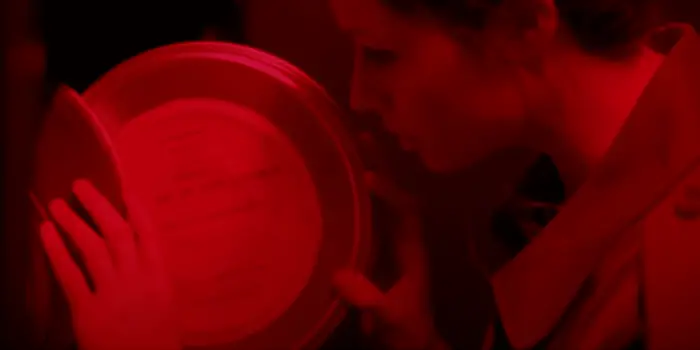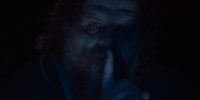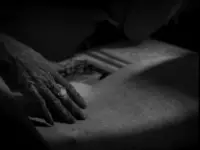Before you watch a single second of Censor, the title alone tells you what it’s going to be about. And I’m not just talking about the main character’s job. Sure, the protagonist literally works as a film censor, but the movie’s name has a deeper meaning as well. At its core, Censor asks a question: Do violent and disturbing horror films cause violence? A lot of people believe they do, so they think we should censor these movies and protect impressionable young (and sometimes not so young) minds from their harmful effects.
But is that really the case? Do horror films really cause people to commit heinous crimes? Censor tackles this charge head-on, and it does so in a way that’s both totally unexpected and completely satisfying. Through its multiple narrative twists and turns, it forces us to think more deeply about this very important question. By the time the credits roll, it makes a convincing case that violence comes from inside of us, not from the movies we choose to watch.
An Initial Answer

When Censor begins, we see the main character Enid talking with one of her coworkers about the cuts she’s making to a movie. Towards the end of the conversation, she says, “We can’t afford to make mistakes.” Then, a few scenes later, we see Enid having dinner with her parents, and she tells them that she does what she does “to protect people.”
Those two lines make it very clear just how seriously Enid takes her job. She fully believes that violent and disturbing horror movies are legitimately dangerous. While she doesn’t explain exactly how she thinks they can harm their viewers, the implication is that she thinks they cause violence. This was the main argument of the video nasty controversy that forms the backdrop for the entire story, and the film’s opening credits feature a voiceover of someone making exactly this argument.
But is that true? Do horror movies really cause violence? As I said before, that’s the major question of this entire film, and a little bit later, Censor gives us our first hint at an answer. At one point in the movie, Enid and another censor are called into their boss’s office, and he gives them the worst possible news: a movie they passed has caused a real-life tragedy. A man killed his wife and then ate her face, and people are linking this vicious crime to a movie called Deranged, in which one of the characters does pretty much the same thing.
When Enid hears this, you can see the anguish on her face. She’s super upset that innocent people were harmed by a violent horror movie, and she’s ashamed that she and her coworker let the film pass. She believes she has failed in her duty as a film censor, and that she is responsible for what this poor woman suffered.
Now, Censor doesn’t tell us if she’s right, but the implication seems to be that she is. All we know at this point is that the man’s crime is suspiciously similar to that scene in Deranged, so it appears that horror movies really might cause violence. Granted, we can’t be 100% sure, but as the story progresses, that conclusion seems to become more and more certain.
A Shady Character

Soon afterwards, a man named Doug Smart goes to Enid’s office to talk to one of her bosses, and he says he produces a lot of the movies Enid and her coworkers censor. Significantly, he has a brief discussion with Enid as he’s walking in, and he comes across as a total sleazeball. He barely makes any effort to hide the fact that he wants to get her in bed, so the entire scene is a bit uncomfortable. You just want him to leave her alone, and when he finally walks away, you can’t help but breathe a sigh of relief.
This is a great scene because it subtly reinforces Enid’s perception of violent horror movies in a way we might not even realize. Sure, on the surface, it doesn’t have anything to do with the potentially harmful effects of the horror genre, but it works on us subconsciously and disposes us towards agreeing with her point of view.
See, this is the first time in Censor that we see anybody involved in the horror industry, so it’s our first impression of the filmmakers behind the genre. And like any first impression, it goes a long way towards forming our opinion. When we realize that Doug Smart is a womanizing scumbag, it subtly pushes us to view the entire horror industry in a negative light. It quietly suggests that the entire industry is made up of bad people, so it makes total sense that their movies would be harmful to viewers.
Enid Goes Crazy

Sometime later, Enid watches a film called Don’t Go in the Church, the plot of which seems to be based on the day her sister went missing when they were children. It deeply affects her, so she seeks out another film by the same director, Frederick North, to see if she can find any more connections between his work and her sister.
Lo and behold, when she sees the lead actress in that next movie, a woman named Alice Lee, she becomes convinced that it’s her sister, which leads her further down the rabbit hole. When she goes to Doug Smart’s home to find out more information, he tells her that North is making a sequel to Don’t Go in the Church and that it’s going to be Alice Lee’s last movie.
Unsurprisingly, he says all this in just about the creepiest way possible, reinforcing the bad first impression he made the last time we saw him. In fact, he comes across even worse in this scene because he seems to imply that he and Frederick North are going to do something terrible to Alice Lee after this next film is done. On top of that, he comes onto Enid even more strongly than he did the last time. As a result, we can’t help but think that he and all of his industry colleagues are terrible people who use and abuse people (particularly women) for their own selfish ends.
However, Censor soon flips the script on us, as we realize that the horror filmmakers aren’t the real bad guys in this story. Enid predictably rejects Doug’s advances, so he grows angry and becomes aggressive. There is a brief struggle during which Enid accidentally kills him.
And this is where things begin to get really interesting. While you can tell that Enid is deeply upset by what she’s done, she reacts to it in a very strange way. She doesn’t try to get help, nor does she attempt to cover it up. Instead, she just looks at Doug as he lies dying on the floor, thanks him for the whiskey he gave her, and then leaves.
It’s all very odd, and it clues us in that Enid isn’t the perfect angel she makes herself out to be. She censors movies because she wants to protect people from violence, but she herself just killed a man and barely even flinched. That’s pretty much the height of hypocrisy. In fact, this is the first genuine act of violence we see in Censor, and significantly, it’s not caused by a movie. This tells us in no uncertain terms that violence doesn’t really come from horror films, something the rest of the story bears out even further.
Correlation, Not Causation

Almost immediately afterwards, we see Enid go back to her office, where we learn more about the man who ate his wife’s face. He has testified in court that he has actually never seen Deranged, the film that supposedly inspired him, so there couldn’t have been any connection between that movie and his heinous crime.
And that’s really significant. Remember, this incident seemed to imply that horror movies do in fact cause violence, but the truth doesn’t actually support that claim. Instead, it reminds us that correlation isn’t causation. Despite the similarity in this case between a fictional murder and an actual one, there’s no real causal link between horror movies and real-life violence.
Now, that revelation is telling enough in itself, but it becomes even more meaningful when we consider the timing of it. It comes immediately after Enid kills Doug Smart, and that’s not a coincidence. This revelation is thematically connected to that key turning point, and when we view these two scenes together, their significance becomes impossible to miss. They let us know without a doubt that horror movies don’t in fact cause violence. Rather, violence comes from inside of us.
The Big Finale

All of this leads us to a big finale in which Enid goes to the set of Frederick North’s sequel to Don’t Go in the Church, and it plays out according to the same pattern we’ve seen a few times already. When Enid first arrives, the situation seems really shady, once again tempting us to view horror filmmakers as terrible people. However, it soon becomes clear that this perception is incorrect.
It turns out that the filmmakers here are just normal people doing their job, but Enid doesn’t realize that. She goes crazy on set, murders one of the actors and the director, and kidnaps a visibly terrified Alice Lee, believing that she’s rescuing her long-lost sister. Once again, Censor gets us to think that maybe horror really is as bad as some people say it is, but then it pulls the rug out from under us and shows us the truth.
And in case that’s not enough to make the film’s point, two more elements in the third act hammer it home even further. First, when Enid meets Frederick North, he tells her, “People think that I create the horror, but I don’t. Horror is already out there in all of us. It’s in you.” Predictably, Enid denies this, believing that she’s somehow above all the horror and evil that permeate the world we live in, though she is obviously wrong.
As Censor shows again and again, there’s actually a lot of horror in Enid. Granted, she’s not entirely culpable for it, as it stems from her mental instability and her unresolved childhood trauma, but the point still stands. It has nothing to do with Frederick North, Doug Smart, or any other horror filmmaker. The terrible acts she commits come from within her, not from horror movies.

Enid’s complete mental breakdown by the end of the film further illustrates its message. As Enid brings Alice to her parents, she hallucinates a voice on the radio saying that “video nasties have been eradicated completely” and that crime and unemployment are at all-time lows. Hearing this, Enid believes her work as a film censor has been vindicated.
But that’s obviously not true. Censor has shown us multiple times that horror movies don’t really cause violence, so banning them (or at least the most violent ones) won’t have anywhere near the kind of dramatic impact on society that she imagines. In fact, as this is all happening, the film interrupts Enid’s fantasy with brief shots of what’s really going on, and we learn that she’s actually kidnapped the poor actress. We see that Alice Lee is begging to be let go, and Enid’s parents are horrified at what she’s done.
Significantly, none of this was caused by a horror movie, so Enid’s hallucination is a sort of satire on the belief that horror films really do cause violence. The juxtaposition of her fantasy and the grim truth sums up the point of Censor in a very bluntly effective way, so by the time the credits begin to roll, it’s just about impossible to miss.
Despite what people like Enid believe, we can’t blame our problems on horror movies. That’s just a cheap cop-out that avoids the real problems in society; if we want to truly make the world a better place, we have to look elsewhere. As Frederick North says, to find the real source of the horror that haunts our world today, all we have to do is look inside ourselves.



